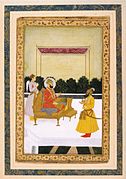Sayyid Hussain Ali Khan Barha
| Hussain Ali Khan Barha | |||||||||
|---|---|---|---|---|---|---|---|---|---|
| Nawab of Aurangabad Nawab of Multan Nawab of Subahdar the Deccan Nazim of Patna Faujdar of Hindun-Banyan Umdat-ul-mulk, Amir-ul-Umara, Bahadur, Feroze Jung, Sipah Sardar, Mir Bakshi | |||||||||
 A portfolio of Hussain Ali Khan. The Nastaliq script read: Amir al Umara, Nawab Sayyid Hussain Ali Khan Sakin Barha. | |||||||||
| Aurangabad | |||||||||
| Under nominal Mughal suzerainty | 1715 – 1721 | ||||||||
| Predecessor | Dianat Khan | ||||||||
| Successor | Nizam Al Mulk | ||||||||
| Born | Hussain Ali Khan 1666 Jansath | ||||||||
| Died | 8 October 1720 (aged 53–54) | ||||||||
| Burial | Maqbara of Sayyid Mian, Ajmer | ||||||||
| |||||||||
| House | Barha | ||||||||
| Father | Sayyid Mian Abdullah Khan I | ||||||||
| Religion | Islam | ||||||||
| Occupation | Commander of Mughal Forces | ||||||||
Nawab Sayyid Hussain Ali Khan Barha (1666 – 8 October 1720), was a kingmaker of the later Mughal Period. Best known for ordering the death of the Emperor Farrukhsiyar largely in attempt to halt the numerous assaination attempts that the latter had ordered against him and his brother Abdullah Khan Barha. Hussain Ali Khan rose as a kingmaker in early 18th century India, when he was also the de jure ruler of Aurangabad, ruler of Ajmer by proxy and Subedar of the Deccan[1]
Both Hussain Ali Khan and his brother, Abdullah Khan II, had a hand in the installation or deposition (or both installation and deposition) of several emperors to the throne at Delhi, including: Bahadur Shah I,[2] Jahandar Shah,[3] Furrukhsiyar, Rafi ud Darajat, Shah Jahan II,[4] Ibrahim[5] and Muhammad Shah.[6] and eventually became de facto rulers of the sub-continent by the early 18th century, at a time when India's economy was the largest in the world.[7]
Early Life and Family[]
Barha was the second son of the Nawab of Ajmer, Sayyid Mian Abdullah Khan I. His family were descendants of the fourth Rashidun Caliph, Ali, and after migrating in ancient times to India, the family quickly became established as nobles of the sword a status they held under various empires, notably including the Delhi Sultanate and later the Sur Empire.[8][9][10] Under the Mughals the family was firmly regarded as old nobility and by the reign of Aurangzeb they held the prestige of being Nawabs of Ajmer or Dakhin, premier realms typically reserved for princes of blood.[11]
He started his early career as a Faujdar under Aurangzeb's reign and eventually gained higher positions after backing Bahadur Shah I in the succession war ensuing Aurangzeb's death.
Biography[]
Hussain Ali Khan served as Bakhsi (the premier general or defence minister of the empire, with powers often extending beyond the war office)[12] of the Mughal Empire and personally oversaw the end of Ajit Singh's rebellion.[13] He is noted by William Irvine to have been "Really friendly to the poor and non-oppressive in disposition." During his time as the ruler of Aurangabad, Barha began a reservoir, a bridge and other works for the public.[14]
Death[]
He was eventually assassinated by Turkish nobles also known as the Turani faction. On the pretext of presenting a petition concerning his malnourished troops, Haider Beg Dughlat fatally stabbed Hussain Ali Khan as his attention was diverted to reading the petition. Haider Beg Dughlat was immediately killed by Hussain Ali Khan's fourteen year old nephew Sayyid Nurallah Khan (Sayyid Nur Ali) who was himself immediately killed by Mughal troops. According to the historian Khizr Khan, Hussain Ali Khan was buried in his fathers tomb at Ajmer.[15]
Titles[]
Upon helping the Emperor Farrukhsiyar to the throne of Delhi, Hussain Ali Khan Barha was awarded with the position of Mir Bakshi and granted the following titles and appellations: Umdat-ul-mulk, Amir-ul-Umara, Bahadur, Feroze Jung, Sipah Sardar.
Depictions[]

The Emperor Furrukhsiyar receiving Hussain Ali Khan.

Abdullah Khan (Gold Cummerbund) with his brothers. Seated opposite his younger brother Nawab Hussain Ali Khan Barha (without a cummerbund).
References[]
- ^ Irvine, William. The Later Mughals. p. 34 (Vol.2). ISBN 9649700471.
- ^ Irvine, William. The Later Mughals. p. 204. ISBN 1290917760.
- ^ Irvine, William. The later Mughals. Low Price Publications. p. 205. ISBN 8175364068.
- ^ Kazim, Sayyid Ali. "A critical study of the role and achievements of Sayyid brothers": 1. hdl:10603/57016. Cite journal requires
|journal=(help) - ^ "Past Present: King Makers".
- ^ "List Of Rulers Of South Asia". www.metmuseum.org.
- ^ The world economy : historical statistics. Development Centre of the Organisation for Economic Co-operation and Development. 25 September 2003. ISBN 978-92-64-10414-3.
- ^ Alami, Abu'l Fazil (2004). The Āʼīn-i Akbarī (2nd ed.). Sang-e-Meel Publications. ISBN 9693515307.
- ^ Sirhindi, Yahya (2010). Tareek-e-Mubarak Shahi. ISBN 978-8175365056.
- ^ Irvine, William. The Later Mughals. p. 201. ISBN 1290917760.
- ^ William, Irvine. The Later Mughals. p. 203. ISBN 978-1290917766.
- ^ "Mughal Administration 2 of 16". www.columbia.edu. Columbia University.
- ^ Irvine, William. The Later Mughals. p. 287. ISBN 1290917760.
- ^ Irvine, William (2007). Later Mughals. Sang-e-Meel Publications. p. 96. ISBN 978-9693519242.
- ^ Irvine, William (2007). Later Mughals. Sang-e-Meel Publications. pp. 59–60. ISBN 978-9693519242.
This article needs additional or more specific categories. (July 2019) |
- 1666 births
- 1720 deaths

